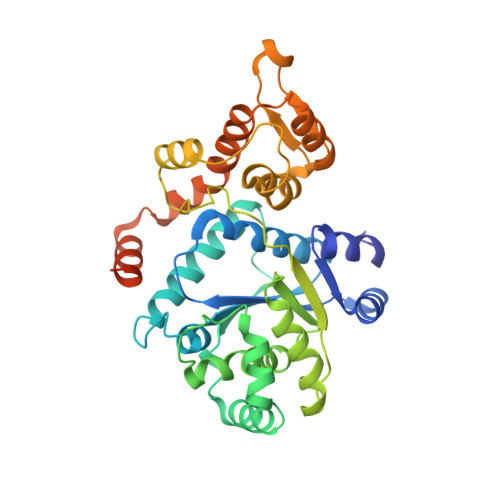A human tRNA synthetase is a potent PARP1-activating effector target for resveratrol.
Sajish, M., Schimmel, P.(2014) Nature 519: 370-373
- PubMed: 25533949
- DOI: https://doi.org/10.1038/nature14028
- Primary Citation of Related Structures:
4Q93, 4QBT - PubMed Abstract:
Resveratrol is reported to extend lifespan and provide cardio-neuro-protective, anti-diabetic, and anti-cancer effects by initiating a stress response that induces survival genes. Because human tyrosyl transfer-RNA (tRNA) synthetase (TyrRS) translocates to the nucleus under stress conditions, we considered the possibility that the tyrosine-like phenolic ring of resveratrol might fit into the active site pocket to effect a nuclear role. Here we present a 2.1 Å co-crystal structure of resveratrol bound to the active site of TyrRS. Resveratrol nullifies the catalytic activity and redirects TyrRS to a nuclear function, stimulating NAD(+)-dependent auto-poly-ADP-ribosylation of poly(ADP-ribose) polymerase 1 (PARP1). Downstream activation of key stress signalling pathways are causally connected to TyrRS-PARP1-NAD(+) collaboration. This collaboration is also demonstrated in the mouse, and is specifically blocked in vivo by a resveratrol-displacing tyrosyl adenylate analogue. In contrast to functionally diverse tRNA synthetase catalytic nulls created by alternative splicing events that ablate active sites, here a non-spliced TyrRS catalytic null reveals a new PARP1- and NAD(+)-dependent dimension to the physiological mechanism of resveratrol.
Organizational Affiliation:
The Skaggs Institute for Chemical Biology, The Scripps Laboratories for tRNA Synthetase Research, Department of Molecular and Cell Biology, The Scripps Research Institute, 10550 North Torrey Pines Road, La Jolla, California 92037, USA.



















